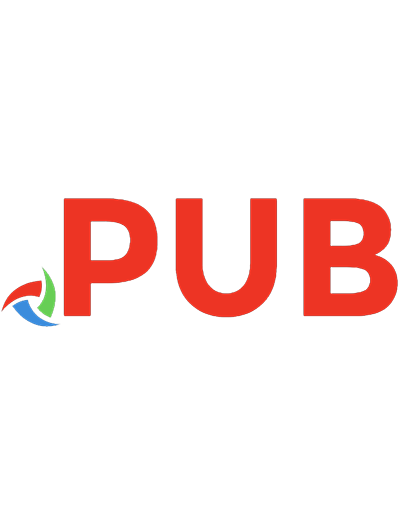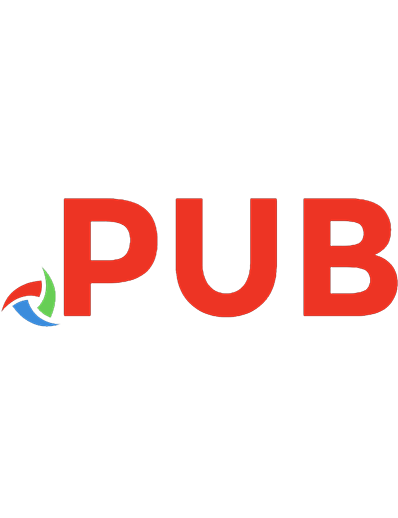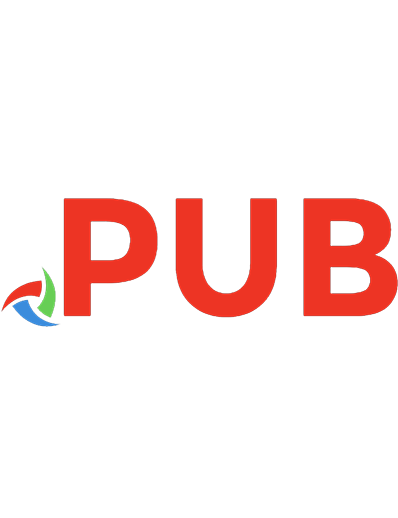Tech SEO Guide: A Reference Guide for Developers and Marketers Involved in Technical SEO 9781484290538, 9781484290545, 1484290534
Tech SEO Guide provides a reference for everyone who works on the technical side of SEO. SEO has always had a technical
160 106 2MB
English Pages 161 [155]
Table of contents :
Contents
About the Author
About the Technical Reviewer
Introduction
Chapter 1: Crawling and Indexing
What Are Search Robots?
Search Robot Operations
What Is Crawl Budget Optimization?
What Is Mobile-First Indexing?
Methods to Guide Robots
Disallow: Robots.txt
Noindex: Meta Robots
Using Noindex and Disallow Directives
Index or Noindex?
Disallow or Allow?
Forbidding Access
Handling Staging Environments
Do Not Block JavaScript (JS), Cascading Style Sheets (CSS), Images, or Videos
Nofollow: Meta Robots
Follow or Nofollow and Page Sculpting
Link Qualifiers and Rel Nofollow
X-Robots-Tag
In Practice: Troubleshooting Google Not Crawling or Indexing Pages
Step 1: What Pages Should Be Crawled and Indexed?
Step 2: What Noindex or Disallow Directives Currently Exist?
Step 3: Are Pages Being Crawled?
Step 4: Can Robots Crawl the Page?
Step 5: What Index Issues Are Present?
Step 6: Is There a Crawl, Index, or Rank Problem?
Measuring and Monitoring Guidelines: Crawling and Indexing
Chapter 2: URL and Domain Structure
What Are the Parts of a URL?
What Is a Canonical URL?
What Is a Canonical Domain?
Why Select a Canonical Domain?
HTTPS Protocol and SSL Certificates
Should My Domain Use WWW or Non-WWW?
Enforcing a Canonical Domain
Should a Website’s Pages Be Located on a Subdomain?
Should Individual Pages Be in the Root Directory or in Subfolders?
Should Individual Pages Be a File or a Subfolder?
What Is Excessive Folderization?
Optimizing a Page’s URL
Using a Trailing Slash
Duplication Resulting from Query Strings
Duplication from Multiple Query Strings
In Practice: Merging a Blog Subdomain
Questions and Considerations
Review Existing Constraints
Changing Blog Platforms
Reviewing Blog Performance
How Related Is the Content?
Completing the Merger
Steps 1–3: Preparation
Step 1: List All Subdomain Files
Step 2: Collect All Data About Each Page
Step 3: Establish New URL Structures
Steps 4–6: Merge
Step 4: Move Subdomain Content to New Website
Step 5: Add Redirects and Update Previous Redirects
Step 6: Update Internal Links and XML Sitemap
Step 7: Measure and Monitor
Measuring and Monitoring Guidelines: URL and Domain Structure
Chapter 3: Content Structure
Title
Meta Description
Header Tags
Image Alt Text
SVG Alt Text
Rendering
Client-Side Rendering and Robots
What Is Dynamic Rendering?
What Is a Noscript Tag?
Pagination
Infinite Scrolling and Load More
What Is Duplicate Content?
Why Does Duplicate Content Present a Problem?
Examples of Duplicate Content
What Is a Canonical URL?
Other Ways to Resolve Duplicate Content…
What Are Thin Content Pages/Doorway Pages/Cookie-Cutter Pages/Low-Quality Content?
Low-Quality Content Problems
What Are Orphaned Pages?
Multilingual Websites and Pages
International Page Variations
Language Defaults
In Practice: Content Assessment
Step 1: Obtain a Full List of Website Page URLs
Step 2: Page Information
Step 3: Page Metrics
Content Assessment Schedule
Measuring and Monitoring Guidelines: Content Structure
Chapter 4: Schema and Structured Data Markup
What Is Schema Markup?
What Are Properties and Types?
How Does Schema Improve SEO Performance?
Does Schema Markup Help a Page Rank?
Do Googlebot and Bingbot Have to Use Schema Markup?
Can Schema Markup Cause Manual Actions?
What Schema Code to Use?
JSON-LD, Microdata, and RDFa
In Practice: Writing Schema
JSON-LD Example: Organization Schema
Microdata Example: Simple Review Schema
Automating Schema Markup
Measuring and Monitoring Guidelines: Schema Markup
Chapter 5: Sitemaps
What Is a Sitemap?
What Are HTML Sitemaps and Are They Needed?
What Is an XML Sitemap?
XML Sitemap Size Limits
What Is an XML Sitemap Index File?
What Pages Should Be Included in the XML Sitemap?
XML Sitemap Structure
Image XML Sitemap
Video XML Sitemap
Multilingual and International XML Sitemap
Additional XML Namespace (XMLNS) Attributes
Submitting XML Sitemaps
In Practice: Reviewing and Cleaning XML Sitemap Files
Step 1: Validate the XML Document
Step 2: Check Canonical Domain Usage
Step 3: Check for Errors, Nonindexable, or Noncrawlable Pages
Step 4: Check for Content-Related Issues and Missing Pages
Step 5: Check Videos and Images Are Listed Correctly
Step 6: Check Multilingual and Internal URL Listings
Step 7: Check Google Search Console and Bing Webmaster Tools
XML Sitemap Checking and Cleaning Schedule
Measuring and Monitoring Guidelines: XML Sitemaps
Chapter 6: Page Experience: Core Web Vitals and More
What Is Core Web Vitals?
What Is First Input Delay?
What Is Largest Contentful Paint?
What Is Cumulative Layout Shift?
Other Speed Metrics
How to Reduce Website’s Load Time
What Is Mobile Friendliness?
Reviewing Mobile Website Methods
Mobile Equivalency: How to Remove Content on Certain Devices?
Interstitials, Modals, Dialog Boxes, and Pop-Ups
Mandatory Interstitials
Safe Search and Meta Rating
In Practice: Using Split Tests to Optimize Website Speed
Identifying Longer-Loading Files
Determine the File’s Purpose
Group Files by Functionality
Structuring the Split Test
Evaluating the Results
Speed Is Never the Primary Goal
Measuring and Monitoring Guidelines: Page Experience
Chapter 7: Not-Found Errors
What Are Not-Found Errors?
Defining Related Terms: “Not Found,” “404,” “Broken Link,” “Missing Page,” “Broken Page,” “Error Page”
Why Do Not-Found Errors Matter?
What Are Broken Backlinks?
What Are Broken Internal Links?
What Are Other Sources of a Not-Found Error?
404 and 410 Response Status Codes
What Is a Soft 404?
What Is a Redirected 404?
How to Format a Not-Found Error Page
In Practice: Fixing 404 Not-Found Errors
Collect Error Information
Method #1: Redirecting Not-Found URLs
Method #2: Correcting Source Link
Method #3: Restoring Removed Pages
Method #4: Ignoring the Not-Found Error
Preventing Errors by Predicting Typos
Regularly Finding and Fixing Not-Found Errors
Measuring and Monitoring Guidelines: Not-Found Errors
Chapter 8: Redirects
What Are Redirects?
Why Use Redirects?
Does the URL Have to Change?
If URLs Must Change...
Where to Redirect?
Avoid Home Page Redirects
What Are Redirect Chains?
What Are Redirect Loops?
Server-Side Redirects
301 and 302 Response Codes
307 and 308 Response Codes
Client-Side Redirects
Client-Side Redirect Option 1: JavaScript Redirect
Client-Side Redirect Option 2: Meta Refresh
Redirect Map
Three Benefits (Among Others) of Using a Redirect Map
How Long to Keep Redirects?
In Practice: Review and Clean Up Existing Redirects
Step 1: Build Redirect Map
Step 2: Reviewing Redirect Destinations
Step 3: Reviewing Redirect Sources
Step 4: Review Other Redirect Use Cases
Regularly Checking Redirects
Measuring and Monitoring Guidelines: Redirects
Chapter 9: Conclusion: Tech SEO Audit
Question #1: Is the Website Crawlable?
Question #2: Is the Website Indexable?
Question #3: Is the Website Ranking and How Is It Ranking?
An Ongoing Process
Appendix A: HTTP Response Status Codes
References
Chapter 1: Crawling and Indexing
Chapter 2: URL and Domain Structure
Chapter 3: Content Structure
Chapter 4: Schema and Structured Data Markup
Chapter 5: Sitemaps
Chapter 6: Page Experience: Core Web Vitals and More
Chapter 7: Not-Found Errors
Chapter 8: Redirects
Appendix A: HTTP Response Status Codes
Index









